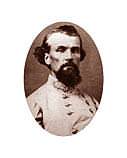You might have a point there. They say about the British army that it loses all its battles except the last one and I think their uniforms are pretty frumpy-except for parade costumes.
However, I take issue with your analysis of Confederate uniforms. The Confederates were so poor that half of them were wearing captured Yankee uniforms. The idea of Confederate gray is largely a misnomer, many of them had butternut as a result of home weaving. General Lee put on his best uniform which he rarely wore to maintain the dignity of his army while he alone underwent the indignity of the surrender, an unavoidable but honorable act forced upon them by circumstance which all the efforts of duty and honor could not avoid. Upon learning that he was surrounded with no hope of reinforcements, that his military situation was hopeless, Lee remarked, "Then there is nothing for it but I must go to General Grant and surrender and I would rather die a thousand deaths." With that action he performed his last duty as a soldier and picked up his duties as a citizen of the Federal Republic which he served faithfully until his death.

When Lee had to abandon his baggage, he picked out his best uniform, sacrificing the others to the G-ds of Battle. Meanwhile Grant rode all night through muck and mire, driving his men to cut off Lee’s army before they could escape to the mountains.
Lee did not go alone, but rather, took his staff. A good thing too, as none of Grant’s staff had the office supplies needed to document the offer of surrender and its acceptance.
And the Union generals forbad celebrations which would rub salt into the wounds of the rebels, since after all, they were our countrymen again.
Bedford, I'd just like to clarify some of what you said about Confederate uniforms. As a former "campaigner" CW reenactor with a pretty hard core outfit, with a Master's degree specializing in U.S. military history at Virginia Tech, I have some expertise in Confederate military culture, tactics, dress, and accoutrements.
It is true that Confederate soldiers were usually poor and often had a ragged appearance, especially in 1861 and 1862. After the Confederate government dropped the commutation system in late 1862 though in favor of the depot system, Confederate soldiers actually started receiving fairly decent quality uniforms made out of homespun cotton/wool mix jean cloth. In fact, they were occasionally better outfitted than their Union counterparts, especially when blockade runners arrived bringing British Isaac Campbell buttons, fabric, belts, cap pouches, cartridge boxes, knapsacks, as well as Enfield rifle-muskets and bayonets.
The butternut effect you describe was not due to "home weaving," but because of the nature of the vegetable dyes used in manufacturing jackets and trowsers. The original colors WERE grey, per Confederate Quartermaster regulations, BUT, after a couple of weeks out in the sun and marching on dusty roads, the grey uniforms oxidized and faded to a khaki-butternut color. It was the poor chemistry of the time that cause the butternut coloring, and not a deliberate choice.
I have a museum-quality reproduction Richmond Depot Type II jacket made using period jean cloth fabric and vegetable dyes, and it faded to butternut after only five or six events.
Of course, in 1864, Isaac Campbell started importing more and more high-quality British blue-grey "kersey" wool through the blockade, which went mostly to Lee's troops, and up until the surrender, the Army of Northern Virginia was relative well supplied with clothing. The Army of Tennessee, not so much so.
Here's some informational links on the subject:
THE GENERIC CONFEDERATE
A SURVEY OF CONFEDERATE CENTRAL GOVERNMENT QUARTERMASTER ISSUE JACKETS, Part 1
A SURVEY OF CONFEDERATE CENTRAL GOVERNMENT QUARTERMASTER ISSUE JACKETS, Part 2
